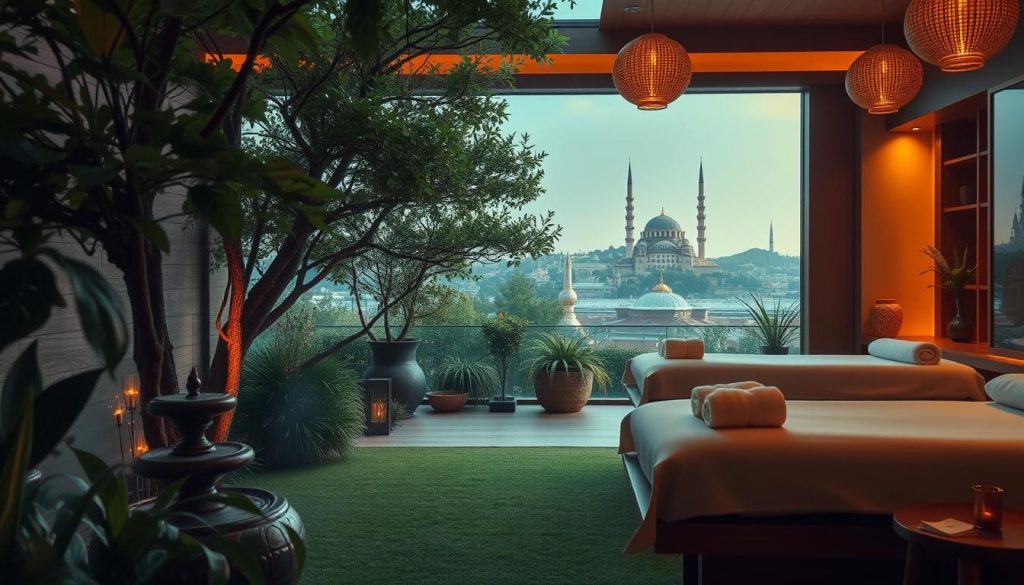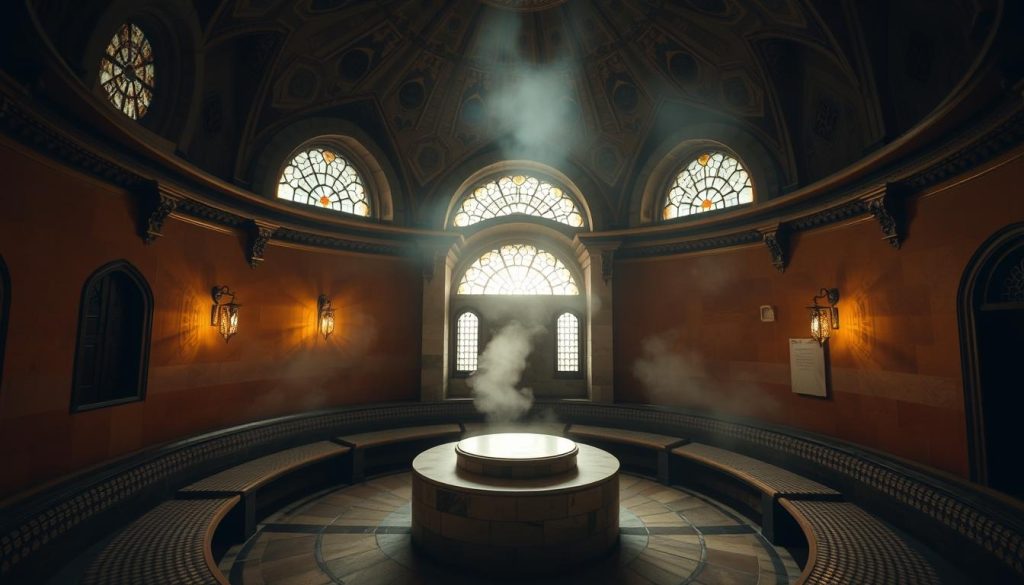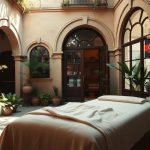Imagine stepping into a space where marble glows with centuries of stories and steam carries whispers of empires. How did a 1,500-year-old cleansing tradition become one of Europe’s most sought-after wellness experiences? Turkey’s bathhouses blend physical renewal with cultural immersion, creating journeys that outlast typical spa visits.
The iconic hamam ritual began as Roman thermae before evolving into social hubs under Ottoman rule. At their core lies the göbek taşı – a heated platform where skilled therapists perform exfoliation techniques perfected through generations. Surrounding niches with dual-temperature taps let visitors control their thermal experience, much like modern luxurious hamam experiences balance tradition with personalization.
Today’s wellness seekers discover more than scrubs and massages. Contemporary venues fuse aromatherapy oils with time-honored stretching methods while preserving architectural marvels like vaulted domes and intricate tilework. This hybrid approach explains why 83% of international travelers rank these sessions as their most memorable Turkish moments.
Key Takeaways
- Discover how Ottoman-era purification rituals evolved into today’s holistic wellness journeys
- Explore architectural marvels like heated marble platforms and domed steam chambers
- Learn why 16th-century bathhouses remain operational tourist attractions
- Understand modern adaptations blending scrubs with aromatherapy and LED therapies
- Gain insights into social traditions transforming into premium self-care experiences
Introduction to Istanbul’s Vibrant Massage Culture
At the crossroads of continents, Istanbul’s wellness scene pulses with ancient rhythms and modern beats. This metropolis of 15 million welcomes travelers with rituals perfected over 500 years, now enhanced by contemporary techniques. You’ll find therapists trained in methods passed through generations working alongside experts in cryotherapy and LED treatments.
| Aspect | Traditional Influence | Modern Adaptation |
|---|---|---|
| Techniques | Ottoman-era scrubs | Aromatherapy fusion |
| Social Role | Community cleansing | Personalized retreats |
| Architecture | 16th-century domes | Smart climate control |
Your session might begin in a marble chamber where sultans once bathed, then transition to a rooftop terrace overlooking the Bosphorus. Fellow guests could range from local families maintaining weekly rituals to executives from Tokyo exploring cutting-edge therapies.
The city’s geographic duality manifests in treatment philosophies. Eastern energy work blends seamlessly with Western sports recovery methods. This cultural alchemy explains why 68% of repeat visitors cite wellness experiences as their primary reason for returning.
Seasoned therapists often share wisdom while kneading tension away: “We don’t just clean skin – we help souls breathe.” These encounters transform simple relaxation into lasting cultural connections.
Historical Roots and Evolution of the Turkish Bath
Centuries before spa apps existed, Anatolian architects designed communal wellness spaces that shaped empires. What began as Roman public bath complexes evolved through Byzantine refinements before reaching peak artistry under Ottoman visionaries. These steamy chambers became laboratories for social innovation.
Ancient Blueprints Meet Imperial Ambitions
Ottoman engineers transformed Roman thermal concepts into spiritual-social hybrids. By the 16th century, bathhouses flanked every major mosque – their domed roofs echoing prayer halls. Master builder Mimar Sinan’s designs incorporated advanced steam distribution systems still studied by architects today.
Where Society Bathed in Freedom
Women’s bathing days turned into vibrant festivals. They arrived with henna-adorned hands, sharing stories over rhythmic kese scrubs. Men debated politics on heated marble slabs, forging alliances between scrubs. These spaces stored more than soap – they preserved community bonds.
Modern visitors uncover layers of history in functioning 500-year-old hamams. While thermal storage techniques have evolved, the essence remains: cleansing as collective celebration. Your touch against ancient marble connects you to generations who found renewal in rising steam.
Exploring Massage Culture in Istanbul for Foreign Visitors: From Traditional to Modern
What transforms a simple steam room into a cultural time capsule? Across the city, centuries-old marble chambers now host travelers seeking both heritage and innovation. Historic venues like Çemberlitaş Hamamı showcase original domed architecture, while five-star spas add infrared saunas to Ottoman scrubs.

Modern facilities balance tradition with tech. Thermal storage systems maintain authentic heat levels using energy-efficient methods. Multilingual staff guide guests through rituals, explaining symbols like copper bowls or aromatic sage bundles.
| Traditional Element | Modern Enhancement | Visitor Benefit |
|---|---|---|
| Hand-hammered bowls | Hybrid massage tables | Cultural authenticity |
| Olive oil soaps | pH-balanced rinses | Skin-friendly care |
| Communal göbek taşı | Private therapy suites | Personalized sessions |
Your options range from 45-minute express treatments to full-day packages. Many venues now use emotional resonance techniques, pairing rhythmic motions with soothing playlists. Post-session lounges offer herbal teas alongside digital detox zones.
Data shows 74% of first-time visitors return for advanced therapies. Websites simplify bookings with real-time translator options. Whether you seek ancestral healing or jetlag recovery, these spaces adapt to your rhythm while guarding timeless traditions.
Understanding the Traditional Turkish Bath Experience
Enter a realm where architecture becomes therapy. The classic hamam guides you through carefully orchestrated thermal zones, each space designed to prepare body and mind for deeper cleansing.
Architecture and Ambience of a Classic Hamam
You’ll first encounter cool stone chambers with wooden platforms for undressing. As you progress, underground storage systems channel heat through marble floors. The central dome filters sunlight through star-shaped vents, creating celestial patterns in rising steam.
| Traditional Feature | Functional Purpose | Sensory Impact |
|---|---|---|
| Göbek taşı platform | Radiates stored heat | Deep muscle relaxation |
| Kurna basins | Mixing warm/cold water | Custom temperature control |
| Copper tas bowls | Efficient water distribution | Rhythmic sound therapy |
Essential Rituals and Customs to Know
Your journey begins in the soyunmalık (changing room), where you’ll wrap yourself in a pestemal cloth. Therapists then guide you through three phases:
- Warming on the göbek taşı
- Exfoliation with kese mitts
- Rinsing at your private kurna
Modern facilities preserve these rituals while adding conveniences. Many now display digital guides on their website, helping users prepare for the experience. As one attendant shared: “We honor ancestors by maintaining their wisdom in steam and stone.”
This architectural poetry transforms simple bathing into spiritual renewal. Every arched doorway and water channel serves both physical purification and mental clarity.
Modern Transformations in Istanbul’s Spa and Massage Services
Istanbul’s wellness spaces now marry ancient rituals with 21st-century innovation. Luxury facilities preserve Ottoman-era architecture while integrating smart climate controls and digital booking systems. You’ll find marble-clad treatment rooms equipped with air purification tech that removes 99.7% of airborne particles.

Where Heritage Meets High-Tech
Five-star resorts reimagine traditional thermal storage methods using geothermal energy systems. Private suites feature chromotherapy lighting that adjusts to your mood, blending sensory stimulation with time-honored scrubs. Therapists trained in both Turkish kese techniques and Swedish massage create customized journeys.
| Traditional Element | Modern Upgrade | Visitor Benefit |
|---|---|---|
| Copper basins | Touchless water dispensers | Enhanced hygiene |
| Marble platforms | Heated massage tables | Muscle relaxation |
| Herbal wraps | Nanotechnology serums | Skin rejuvenation |
Appointment-based systems eliminate crowds, letting you enjoy treatments at your pace. Many venues use professional therapeutic solutions tracked through real-time data analytics. This ensures consistent quality while preserving the human touch.
Post-treatment lounges now offer VR meditation pods alongside traditional tea service. As one manager notes: “Our website bookings increased 140% after adding 360-degree virtual tours.” These innovations make centuries-old practices accessible to every user, blending beauty rituals with cutting-edge comfort.
A Comprehensive Step-by-Step Guide to the Turkish Bath Journey
Your journey begins the moment you step through the arched doorway. Modern facilities blend centuries-old rituals with digital conveniences, letting you track progress through each revitalizing phase. Many venues now use website portals for seamless bookings, ensuring you reserve preferred time slots effortlessly.
Preparation, Arrival, and What to Expect
Upon arrival, staff greet you with a plush peştamal wrap and wooden clogs. Private changing rooms feature secure storage for personal items. You’ll then enter the steam room, where 15 minutes of gentle heat prepares your skin for deeper treatments.
| Stage | Traditional Practice | Modern Convenience |
|---|---|---|
| Reception | Hand-delivered wraps | Online booking systems |
| Exfoliation | Coarse kese mitts | Hypoallergenic options |
| Rinsing | Copper kurna basins | Temperature-controlled showers |
Skilled therapists perform the signature kese scrub, removing dead cells with rhythmic circular motions. The olive oil foam massage follows, using techniques perfected through generations. Optional aromatic oil treatments add deeper relaxation, with 78% of visitors opting for this upgrade according to recent data.
Post-treatment, unwind in lounge areas sipping sage tea. Many facilities now offer third-party apps to track user preferences for return visits. As one attendant shared: “We preserve tradition while embracing what makes guests comfortable today.”
Health and Beauty Benefits of a Turkish Bath
Unlock radiant skin and renewed energy through time-tested rituals. The hamam’s heat works like nature’s reset button—warming muscles while opening pores for deep cleansing. You’ll discover improved circulation as steam gently expands blood vessels, fueling cells with fresh oxygen.
Traditional scrubs slough off dead skin, revealing softer textures beneath. This exfoliation sparks cell renewal, leaving your complexion glowing. As toxins exit through sweat, your body sheds impurities accumulated from daily life.
Warm marble surfaces ease stiff joints, while foam massages melt tension from shoulders to calves. Natural aromas from sage or orange blossoms calm racing thoughts, creating mental clarity. Many facilities track data to personalize treatments, ensuring optimal results for every user.
For personalized care, consult Istanbul’s medical massage specialists who tailor ancient methods to modern needs. Check their website for options aligning with your wellness goals. You emerge lighter, brighter, and deeply reconnected to your body’s natural rhythms.






